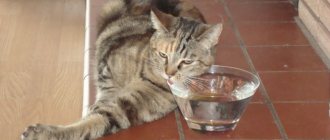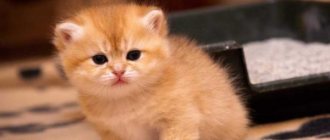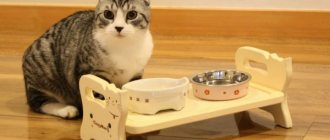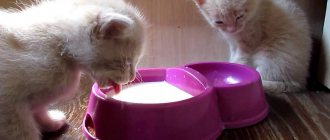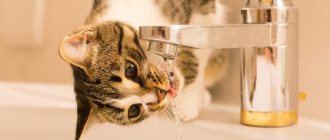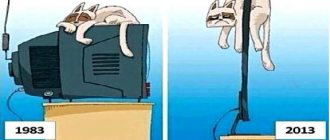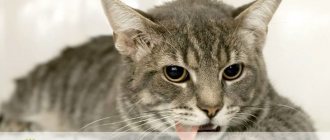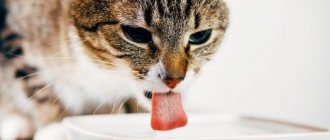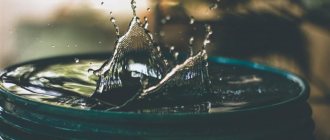Cats are not heavy-drinking animals. Outbred cats drink more actively than their purebred relatives. The animal should drink 20-40 ml of water per kilogram of its own weight per day in order to maintain normal water-salt balance and not have problems with bowel movements.
It is quite easy to understand that a cat has stopped drinking. You don't have to watch the bowl to do this. If the water in your pet’s bowl remains untouched, this does not mean that the animal has gone on a dry strike. If a cat urinates normally, its urine is not too concentrated, and it empties its bowels regularly, which means the animal is getting enough fluid. A healthy young cat can last up to 5 days without water at all, older pets and kittens less. If an animal feels great, it means it gets moisture from somewhere. Cats can drink from completely inappropriate places:
- from aquariums;
- buckets;
- bowls;
- from the tap;
- and even from the toilet.
In order to understand how much your pet drinks per day, felinologists recommend placing containers of water around the apartment, having first measured the volume of water poured. At the end of the day, you need to collect the container and see how much water is left. Please note that the water will evaporate.
The norms of fluid intake are very individual. However, there is a general formula. Every day, for every kilogram of its weight, a cat should drink approximately 30 ml of water. That is, an individual weighing 4 kilograms should drink at least 120 ml of liquid per day.
If the water remains untouched, the cat begins to urinate rarely, the urine is dark yellow in color and has a strong odor, this indicates that the animal is not receiving enough fluid. If a cat has problems with stool, stool has a hard consistency, or constipation, this also indicates a lack of moisture.
Why water is important for cats
Water is vital for any living creature. It performs important functions in the body:
- regulates body temperature;
- transports nutrients;
- necessary for digestion of food;
- helps remove toxins from the body;
- supports the functions of internal organs;
- ensures the functioning of enzymes;
- participates in the functioning of muscles, joints, eyes;
- maintains tissue elasticity.
Therefore, it is important to have enough of it in the diet. In animals that consume little fluid, concentrated urine is dark yellow in color with a pronounced odor. At the same time, they rarely go to the litter box. Constipation is also an indirect sign of insufficient fluid intake. This can contribute to the formation of sand and stones in the bladder. And also a lack of fluid can lead to weakening of the body, metabolic disorders and decreased immunity. It is necessary that your pet has unlimited access to water around the clock.
When is this the norm?
Experienced cat owners know the daily requirement of a pet's body for clean water. On average, the daily volume of fluid consumed is calculated individually and is about 60 ml per 1 kg of the cat’s live weight. If we judge the dry matter - 2 ml of liquid per 1 g of dry part. It is worth noting that not all cats need to drink a strictly regulated amount of liquid. After all, it is necessary to take into account a number of factors that influence not only the loss of fluid, but also the need to replenish it. The main factors are:
- cat nutrition - wet or dry granulated food; the animal eats, drinks milk or soups;
- climate and weather conditions - summer time (heat outside), cold time (dry indoor air);
- age characteristics and breed - increased activity of the pet or, on the contrary, apathy by nature.
At the same time, we must not forget that any domestic cat, even if it does not show much interest in water, should have its own drinking bowl. The water must be changed regularly and ensure that it does not have any foreign odors or impurities in its composition.
Some pet owners give their pets distilled water, believing that it is better purified. Distilled water does not contain microelements and long-term consumption of such liquid provokes disturbances in various body systems. The bowl from which your pet drinks water must be clean, preferably made of ceramic or glass. It is not recommended to use plastic containers.
The cat does not drink, what could be the reasons?
Domestic cats are descended from desert dwellers, and by nature they drink little. Although they do not have a particular need to drink, staying hydrated is important for their health. The daily fluid requirement depends on age, diet, physical activity, and ambient temperature. The most common reasons:
- You may not like the place if the bowl is in a noisy, crowded room with bright lights, or is located next to the tray.
- Your pet may hold a grudge or be stressed. And as a result, refuse to take not only water, but also food.
- The water may be spoiled, have an unpleasant smell of bleach, detergents, or smell of algae to the cat.
- The animal can receive a significant portion of the liquid from wet food.
- Refusal of fluids may be a consequence of the animal’s malaise or illness, accompanied by poor health, weakness, refusal to eat, and increased body temperature.
Perhaps you don't notice how much your cat actually drinks? Street animals often drink from puddles, while domestic animals find unobvious sources: watering cans, flower vases, buckets, toilets, and often drink from the owner’s cups.
Signs of dehydration
Experiments with bowls do not always bring results immediately, and the cat continues to be mischievous. This behavior threatens dehydration and the acquisition of unpleasant diseases.
A small test can help identify dehydration in a cat. Pull back the skin on the cat's neck and watch it return to its original position. If this happens quickly, your pet is fine.
If the fold of skin is difficult to pull back, and then it slowly straightens, the cat is dehydrated. If there are other alarming symptoms, the animal must be immediately shown to a veterinarian.
How much water should a cat drink daily?
An adult, healthy individual needs to consume approximately 40-50 milliliters of fluid per kilogram of body weight daily. The amount of moisture in the feed is also an important point. For example, a pet weighing 4.5 kilograms requires approximately 200 ml of liquid. If a cat eats 170 grams of wet food daily (moisture content 80%), it covers more than half of the daily water requirement, receiving 135 ml of liquid with the food. If he eats only 70 grams of dry food (moisture content 9%), he needs to drink another 180 ml per day. The activity level of pets should be taken into account. The more active your pet is, the more fluid it needs. Also, if the air temperature outside or indoors is above 20 degrees, the need for fluid consumption increases. It is worth noting that sometimes a different drinking regime may be required. So, for certain diseases or after operations, you must strictly follow the veterinarian’s recommendations. Stress factors, for example, a change of place of residence, unknown people at home, a neighbor's cat, affect the behavior of four-legged friends. Often cats drink less in such situations. Let her get used to the new life situation, observe her behavior. The required amount of fluid for the body also depends on age. A kitten's young, growing body requires more fluid. And in old age, this need decreases. It is completely normal for an older cat to drink less than normal.
Symptomatic treatment
When the breeder notices that the cat has become lethargic, she practically does not drink, urination becomes rare, and the litter box smells too bad after each visit, there is no time to hesitate. The faster the animal receives qualified help, the faster the recovery will come.
If there are clear signs of dehydration, such as diarrhea or uncontrollable vomiting, veterinarians will first replace lost fluids and then begin treatment.
If an animal is sick, it may be given glucose injections and saline infusions. Moreover, this is not treatment, but only maintaining the homeostasis of the animal. Treatment of the underlying disease must be carried out without fail. If a cat does not drink, this is a serious sign; without qualified help, the pet may die.
For example, with severe diarrhea, hours can count. Symptoms of dehydration develop quickly. When fluid balance is restored, veterinarians prescribe antibiotic therapy.
If a cat develops a tumor, the prognosis is, unfortunately, unfavorable. There are no effective treatments for cancer of the tongue and oral cavity. The only treatment that the clinic can offer is tongue removal. In this case, the doctor removes a stoma (makes a special hole), through which the cat needs to be watered and fed.
How to train a cat to drink more
Cats are unique and so are their drinking habits. It is impossible to force a pet to do anything, but there are tricks that can be used to influence the animal’s habits. At the same time, it is much more difficult to retrain an adult. Try different options and observe to find out your preferences. Maybe Fluffy prefers running tap water? This means you should think about purchasing a special drinking fountain. It consists of a container and a small pump that ensures constant movement of water and saturation with oxygen. Owners notice that cats are more willing to drink from certain bowls. Some people don't like the whiskers to touch the edge of the bowl and prefer wide, shallow bowls. Others like to drink from large bowls, containers where they can dip their paws, like in a pond. The material of the bowl plays an equally important role. It’s worth experimenting and finding out what you like best: a bowl made of clear glass, ceramics, metal or plastic. You can try changing the location of the bowl. If you can find the right spot, cats will be more willing to drink. Pets may not like it if bowls of water and food are placed nearby and do not like to share bowls with other animals. Many people will disdain to drink next to the tray. Many people like to have several bowls of water placed around the house; they are curious animals, keenly interested in the unusual and new. Using these simple tips, you will find her favorite place. Cats love fresh water, so it needs to be changed daily. But there are exceptions to the rules - some prefer stagnant water. To increase your pet's interest in water, add a couple of drops of cream, milk or meat juice. Please note that you should not give milk and cream in its “pure” form, they contain milk sugar, which causes diarrhea in most cats. By the way, you can prepare meat juice in the form of ice cubes to add flavor. But don't let your cat drink ice water! It should be at room temperature. Animals that prefer clean, fresh water may be disturbed by the taste or smell of tap water. In this case, drinking water purification filters will come to the rescue or use bottled still water. There are no beneficial substances in boiled water, so it is better to give preference to raw water. One way to increase the amount of fluid consumed is to add it to the food. Try soaking dry food or adding a small amount of liquid to wet food. Several small meals daily, consistent with cats' natural feeding behavior. With each meal they drink a little water, since the secreted digestive juices cause a feeling of thirst. It is preferable to choose the frequency of feeding together with your veterinarian, taking into account, for example, the results of a urine test.
Diet with lots of water
If you feed your cat food, it is likely that although she will drink, she will not do so in sufficient quantities to meet her needs. This is why it is recommended to at least offer him a so-called mixed diet, which is nothing more than feeding and wet food, which is canned cat food. So, if you are wondering how to hydrate a cat that doesn't want to drink water, this type of diet has the answer.
Thus, we must calculate the amount of dry food and wet food that our cat needs daily and offer her, for example, half of each diet to create her menu. It's important to take the time to calculate otherwise if we overdo it we risk causing weight gain.
Both products should be given separately and it is recommended to offer them in small quantities several times a day. This is a feeding method that is closer to its natural behavior, and it has also been proven that eating more frequently encourages a cat to drink more times.
On the other hand, remember to choose a quality diet. Spend some time comparing the formulations and ingredients of different brands. There are good options for every budget. It is important that the food you choose is tailored to your cat's stage of life, and if she has any medical conditions, you provide her with a special diet prescribed by your veterinarian for both dry and wet food. Otherwise, the desired positive effects would not be achieved.
Finally, you can feed your cat homemade food if the menu is designed by a cat nutrition expert. Otherwise, nutritional deficiencies and health problems may result.
Is milk acceptable in the diet of an adult cat - benefit or harm?
Veterinarians and nutritionists advise excluding milk from a cat’s diet from 6 months, and some experts suggest doing this earlier - as early as 4 months.
This is due to the fact that this product contains a special element in huge concentration - milk sugar. Its breakdown is carried out in the cat's body under the influence of the enzyme lactose.
The body of any mammal produces quite a lot of it in infancy and childhood and produces practically none at all in adulthood.
This theory is confirmed by almost all experts - product rejection occurs in most individuals, but there are exceptions to the rule.
Some adult and even elderly pets happily drink milk without any consequences for the proper functioning of the body. This is due to the individual characteristics of specific individuals. This means that it is in their body that a lot of lactose is still produced and the breakdown of milk sugars occurs successfully.
All adult animals like the taste of milk, but numerous studies have confirmed that it does not bring any benefit to the pet. Some cats, even in the absence of dyspeptic symptoms, may develop an allergic reaction when feeding them milk.
Thus, despite the assertion of some scientists about the indispensability of cow's milk in the diet of cats, most experts recognize this product as harmful and unacceptable in the diet of adult pets:
- The high calorie content of milk can lead to imbalance in the body and ultimately lead to obesity.
- The high content of casein and lactose does not allow the product to be completely absorbed.
- An extremely high concentration of elements that are unacceptable in the diet of an adult animal contributes to the development of allergies.
- Intolerance to milk sugars by the cat's body leads to indigestion, flatulence, bloating, indigestion, chronic diarrhea and dehydration.
The drinking bowl is dirty!
When figuring out why a kitten does not drink water, you should pay attention to the drinking bowl. Sometimes the answer to this question is very simple: the baby does not want to drink from dirty dishes.
A slimy coating from water may accumulate at the bottom of the drinking bowl, and food may get into the bowl if the bowl of food is nearby. Perhaps the water bowl itself is clean, but the area around it is dirty, and the kitten does not want to get its paws dirty. Cats are very clean and picky animals, so they will not drink from unclean dishes.
A good sense of smell allows a cat to distinguish unpleasant and suspicious odors. Often dishes for animals are made of low-grade plastic, which has a strong smell. It is better to use ceramic, metal or porcelain bowls, which are odorless and easy to clean.
Cat in the wild
Cats drink little and can go without water for a long time.
In fact, murkas are low-drinking animals, and there is no secret in this. Most cats are of desert origin, where there is a priori little water, so the body drew the moisture necessary for normal functioning from the food it caught: game, mammals, reptiles, etc.
Only occasionally, for example, during a period of drought or during a forced hunger strike, did wild predators drag themselves to a watering hole, where they replenished their reserves of necessary liquid. By the way, some representatives of the huge cat family do not drink water at all. Take, for example, the same dune cat or sand cat - the species is considered elusive, because it is simply impossible to meet them near the water.
Let's remember about lions. If possible, they drink every day, but they can easily survive without liquid for up to 5 days, and this will not particularly affect their health. Therefore, there is nothing surprising or extraordinary in the fact that domestic cats, direct descendants of wild cats, drink little - this unique property is inherent in them by nature.
[custom_ads_shortcode2]
Symptoms of dehydration in cats
If your cat eats dry food and does not drink, we advise not to wait for signs of dehydration and contact your veterinarian immediately. However, it is worth being aware of the symptoms of dehydration. Here are the main ones:
- Frequent breathing.
- High and weak pulse.
- Salivation.
- Shiver.
- Urinating too often or too infrequently.
You can also determine whether a cat is dehydrated in the following way. Gently lift the skin from the back of your neck. If she quickly returns to her place, then everything is fine. If the skin slides down slowly or remains in place, your pet needs water.
Up
